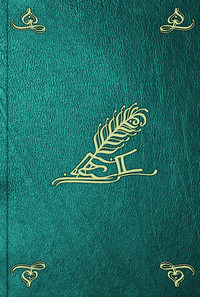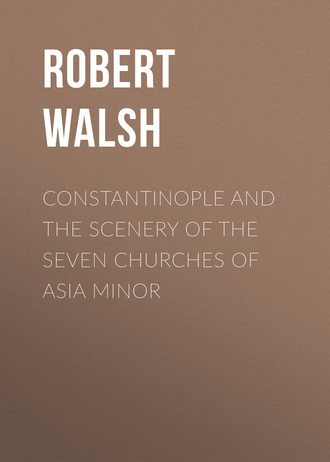 полная версия
полная версияConstantinople and the Scenery of the Seven Churches of Asia Minor
A STREET IN THE SUBURBS OF ADRIANOPLE
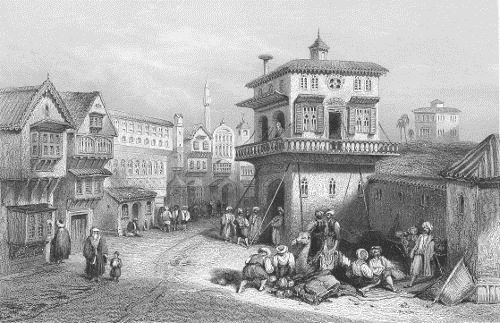
W. L. Leitch. Drawn from Nature by Hervé, Esq. J. Sands.
This capital of Thrace is one of the many towns erected by the emperor Hadrian in the East, and who, from his strong propensity for building, acquired the name of κτιϛσης “the architect.” His travels were marked by memorials of this kind, and his progress is to be traced, not like that of other conquerors, by the ruins, but by the erections he left behind him; and several towns, both in Asia and Europe, still retain his “image and superscription.” He selected for his Thracian city the banks of the classic Hebrus, and for many centuries it continued a flourishing town under the Greek empire. When the Turks passed into Europe in 1362, they seized on it, and, transferring the seat of empire from Brusa, they made Adrianople their capital, and called it Ederne. It so continued for more than a century, till Mahomet destroyed the empire of the Greeks, and there established his seat of government in the imperial city of Constantinople.
The city stands at the confluence of the rivers Toondja and Arda with the Maritza, the modern name for the Hebrus. After this union, the river becomes a noble stream, flowing down to the Archipelago, where it debouches into the Sea, amongst a group of Islands, near to the town of Enos, which is considered the port of Adrianople, and the outlet of its scanty trade. Various streams, flowing through the rich country around the capital, fertilize it to the highest capability of produce, but such advantages are totally neglected. No corn is raised on these exuberant plains, even for their own consumption. When the Russians in 1830 descended from the Balkans, they expected to find well-filled magazines ready for the supply of the army. They found nothing. No stores had ever been laid up, and 8000 men, are said to have perished at Adrianople by want and subsequent sickness. Their advance on Constantinople was suspended, and the indolence and improvidence of the Turks, without intending it, saved their capital.
The present city is eight miles in circumference, and contains about 100,000 inhabitants. It is adorned with many public edifices, and splendid mosques, among which is that of Sultan Selim, supposed to rival that of Sulimanie, or any other in the capital. Its aërial dome is twenty feet higher than that of Santa Sophia, and its symmetrical and beautiful proportions are the admiration of all strangers. On the porch is read one line only from the Koran, as simple as it is noble, “Allah is the light of heaven, which illumines the darkness of the earth.”
THE FORT AND TOWN OF SILIVRIA.
THE ANCIENT SELYMBRIA
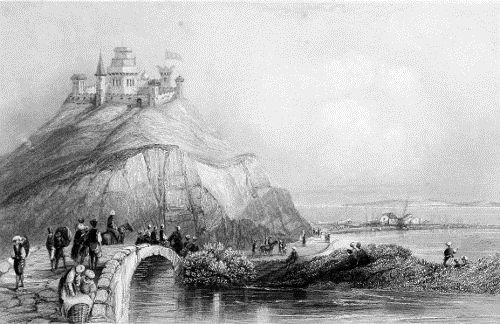
J. Salmon. Drawn from Nature by Hervé, Esq. W. H. Capone.
This maritime town of Thrace is of great antiquity. Not like the former, erected at a comparatively recent period, and by a well-known founder, Silivria was one of the towns of the Thracian or Scythian aborigines, and is mentioned by Herodotus as existing, and ancient in his time, 450 years before the Christian era. It is about twenty miles from Constantinople, and stands on a promontory which forms one extremity of an extensive bay, while the ancient town of Erekli stands on the other. Like all ancient cities, where such a thing was possible, it was built on the summit of a hill, forming what the Greeks call an acropolis. Three sides were of easy approach, and protected by fortified walls; but the fourth, facing the sea, was an inaccessible precipice, as perpendicular as the face of Dover Cliff, so that no wall was necessary. The summit of the hill is a perfect level, and the town forms a quadrangular area open to the sea; and perhaps no other in the world can present so fine and magnificent a platform. It commands the most extensive view along the winding coast, and across the Sea of Marmora, having the beautiful archipelago of the Princess Islands floating as it were on the surface of the sea below; and the splendid view terminates by the coast of Asia, and the snowy ridges of Olympus. The walls are built of hewn stone interlaid with strata of Roman brick as large as flooring tiles. They are pierced by five gates, which are still standing, and closed carefully every night. Part of the area within the walls is now filled up with mean dirty streets, inhabited principally by Jews and Greeks. Below, on the shores of the sea, is another portion of it, almost exclusively Turkish. It has a port, in which lie a fleet of small-craft, used for conveying the produce of the neighbourhood to the markets of Constantinople, and this is all that remains of the bustle and activity of that commerce, which once distinguished the enterprising Greek cities of this coast.
Over one of the gates is an inscription containing the name of Theodora, of whom the Byzantine historians relate an interesting anecdote. “When the Emperor Theophilus wished to select a wife, he announced his intentions; and several ladies, most distinguished for beauty and accomplishments, appeared as candidates for his favour. On the appointed day, they arranged themselves in an apartment of the palace, and the emperor, with a golden apple in his hand, walked along the line to make his choice. He remarked aloud in passing, that women had been the cause of much evil in the world; and a young lady of the group of candidates, named Icasia, and on whom the emperor had fixed his regards, hoping to recommend herself by her wit as well as by her beauty and spirit, immediately replied, that his majesty must allow they had also been the cause of much good. The emperor turned from his fair antagonist with dislike, and, fixing his eyes upon another, who seemed shrinking from notice, he placed the golden apple in her hand, and selected her for his wife. This was Theodora−and she did not deceive his choice. She was afterwards distinguished for her modesty and prudence.” There stands in the area of the esplanade a very ancient Greek church, which she is said to have erected; and, notwithstanding the convulsions of the state, and the desolation of the invading Turks, to have remained in the undisturbed celebration of Christian worship for 1000 years.
Our illustration represents the Acropolis of this ancient city on the summit of a high and lofty hill, with the road at its base, winding to the town and port below, with various peasants bringing baskets of grapes, and other local commodities, for transportation to the markets of the capital.
A TURKISH LETTER-WRITER, AT CONSTANTINOPLE

T. Allom. B. Holl.
There are two modes of communication among the Turks−by symbols, and letters; the first was of very early adoption, and used even on important occasions of state. While Buda was in the power of the Turks, and they threatened to lay siege to Vienna, the vizir of Soliman caused a large water-melon to be conveyed to the Austrian ambassador. The Turks are in the habit of sending presents of fruit as tokens of good-will, and it was supposed that this fine fruit imported no more. It was found, however, that it was meant to exhibit the size of those cannon-balls with which the sultan intended to attack the Christian capital, and so to strike terror into its defenders. The Austrians immediately searched, and found a larger one, which they sent back in return−implying, that the cannon of the besieged was still more powerful than that of their assailants. The Turks were repulsed, and the truth of this emblematic communication verified.
But, besides fruits, flowers of all kinds are used at this day, as means of allegoric communication, among a people so illiterate as the Turks. The rose is principally prized, because the Moslems suppose it grew from the perspiration of Mahomet, and they never suffer the petal of the flower to wither on the ground. In all emblematic communications, it is deemed the representation of beauty and joy: the orange-flower marks hope; the marigold, despair; the amaranth, constancy; the tulip, a reproach of infidelity. It is thus that bouquets of flowers, called selams, supply the place of letters, and the illiterate lover communicates to his mistress feelings and sentiments which the most elaborate written language could not express. In this manner slaves hold tender communication with their mistresses, even in the presence of their terrible master. The captive Greek is generally employed as a gardener: by an ingenious arrangement of a parterre of flowers, he holds mute and eloquent converse with her he loves, even while his jealous rival and master is looking on, and his instant death would follow a discovery.
But, beside these modes of conveying ideas, there are scribes, who sit at the receipt of custom, as at Naples, who live by writing down on paper what the Turk is not able to do for himself. These clerks are found in bazaars, and at the corners of streets, and are distinguished by a calomboyo, or a bright brass “inkstand and pen-case,” stuck in the girdle, where another carries his yatagan and pistols. His desk is generally his hand, and his pen is a reed, like that of the Romans. This necessary person writes for all occasions. Is a Turk going to law, he writes for him his arzuhal, or the state of his case−does he want a protector against any evil, he writes an amulet. The Turks are exceedingly fond of amulets; they suppose them a sufficient safeguard against disease, magic, the power of evil spirits, the malice of enemies, and the assault of robbers. The scribe has power, by transcribing certain passages of the Koran, and annexing certain mysterious ciphers, to give a paper to his customer which will protect him against them all.
Our illustration represents an anxious mother obtaining such a protection for her child: a favourite one for such an age is the Kef Marjam, or “hand of Mary” which is either represented on blue glass, or inscribed on paper, and hung on the head or breast of the child.
THE SQUARE OF THE FOUNTAIN, ADRIANOPLE

W. L. Leitch. J. Tingle.
The city stands in the centre of an enormous plain, 140 miles, or about five days’ journey from Constantinople. It is distinguished by the approaching traveller at the distance of many miles, by the tall minarets of the mosque of Selim piercing the sky, when all other objects of the city are imperceptible. An Oriental town is never discovered like one where coal is consumed, by the dense vapours which fill the atmosphere about it, but obscuring every other object. The site of it is usually marked by some conspicuous building rising above the rest, projecting on the pure air, and seen distinctly at an immense distance. Adrianople is entered on one side by a street, bounded by a vast cemetery having even more solemnity and beauty than is usual in others; this area is intersected by various avenues, and is the constant retreat of the citizens. There is nothing gloomy or revolting in the feelings it excites. The tombs are shaded by the ever-verdant and aromatic cypress, or varied by rose-trees and “flowers of all hues.” It is the constant resort of all the relatives of those who sleep below, and the dead and the living meet here morning and evening in tranquil repose. On another side the city is approached by a wide causeway, the work of its founder, which he intended as the avenue of communication between his new city and Byzantium. It is still used for the same purpose, and forms the highway to Constantinople, but, like all remains of Roman roads in the country, it is so dilapidated by Turkish unskilfulness and neglect, that it is nearly impassable, and travellers, when overtaken on it by darkness, are compelled to light their lanterns, and pass it with the same precaution as the precipice of the Balkans.
In a tour through some of the Turkish dominions in Europe, which Sultan Mahmoud made some years ago, he passed through Adrianople, and paid its state particular attention. He was met by deputations of the various people that compose its population−the Turks headed by their mollas, the Greeks by their ex-patriarch, the Armenians by their vertabiets, and the Jews by their hakim-bashi or high-priest. He distributed large sums of money among them for founding schools, so that the whole population are now in a course of instruction by Lancasterian seminaries, and others on the European system. He also gave directions for building a noble stone bridge across the Maritza, in place of the decayed and tottering wooden structure that he found there. To commemorate these acts of beneficence, a new coinage was struck, having for its emblem a rose on one side, to indicate its principal produce, the attar of roses; and on the other, a star, as a representation of the sultan. It happened, either by accident or design of the Greek artist, that the star was deficient in its rays, and represented only a cross. This was remarked with avidity by the sanguine Greeks, and this coinage of Adrianople was classed, among other similar things, as an indication of his intention to become a Christian.
JOANNINA, THE CAPITAL OF ALBANIA
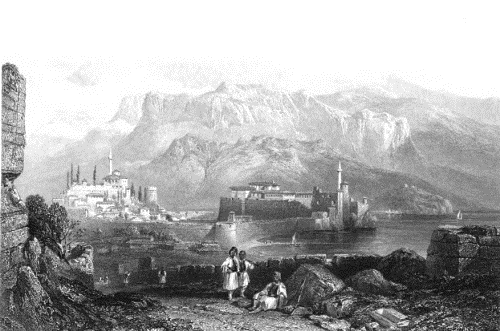
W. L. Leitch. J. Cousen.
The city of Joannina, formerly scarcely known in England to have an existence, became, in later times, highly celebrated, as the capital of the extraordinary man, Ali Pasha, and attracted distinguished visitors from every part of Europe. It seems singular, that the security of its site, the fertility of the plains that surround it, and the beauty and natural advantages of its magnificent lake, should not have attracted the notice of either Greeks or Romans, who in succession held rule in Epirus and Albania, in the latter of which it lies. No trace of any city is discernible here before the reign of John Cantacuzene, in the fourteenth century, and no classic ruins ennoble the barbarous remains of the middle ages. It is supposed to be called Joannina from the Christian name of its founder. It is usually written Yannini.
It continued a Byzantine city till the year 1432, when Amurath II. sent a letter and summons to the inhabitants of Joannina, like that of Sennacherib to the inhabitants of Jerusalem. It reminded them of the calamities inflicted by the conqueror on other cities, and warned them to avoid them by a speedy surrender. The terrified Christians at once submitted, and the Mahomedans took possession of it. Their first act was to raze some of the Christian churches to the ground, and their next was a deed in imitation of the rape of the Sabines:−a body of armed men watched the return of the Christian congregation from the place of worship left yet standing; each man seized upon the girl which best pleased him, as she issued from the porch; and the parents, after in vain exclaiming against the violence, were compelled at length to assent to it. The women became reconciled to their lot, and so a Christian and Moslem population amalgamated, like the Romans and Sabines, and lived in harmony together.
In the year 1611, however, an unfortunate attempt was made to expel the Turks. A fanatic bishop dreamed that he saw the sultan rise up on his throne at Constantinople to greet him, and gave out that this portended his reign in Joannina. He collected some followers, and attacked the Turks; but was speedily defeated, and his skin stuffed, and sent to the capital, where the Sultan, excited by curiosity, rose to look at it, and so completed the prediction of his dream. From that time the Christian inhabitants live in more abject subjection to the Turks than in any other part of the empire.
The present population is estimated at 40,000, for whom there are nineteen mosques, five tekés, six Greek churches, and two synagogues. It is distinguished for its schools, and has produced many learned men. It carries on a considerable traffic with Russia, Venice, and Malta, and is famous for its embroidery, cunning skill in ornamenting swords and other weapons, and particularly for its beautiful chiboques.
THE FAVOURITE ODALIQUE
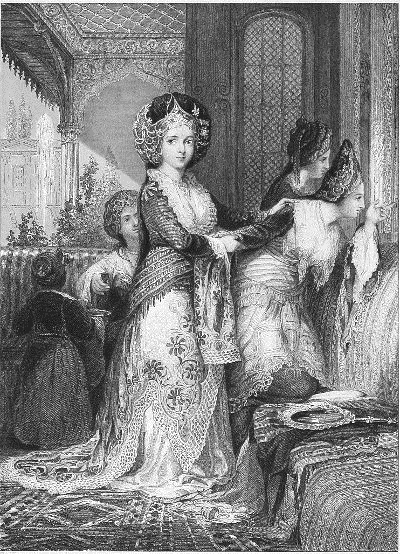
T. Allom. J. Jenkins.
The female inmates of the seraglio are known by the names of Asseki and Odalique. The first is distinguished by having given birth to a son: she has then separate apartments assigned to her, gardens, baths, and even a mosque for her own private devotions. She has a regular income conferred upon her, called Paschmaklik, that is, “the revenue of the sandal.” It is assigned to purchase slippers, and called Turkish pin-money. Whenever a city is taken by the sultan, he generally reserves one street or district of it as a Paschmaklik. An Asseki sometimes builds a mosque from her immense revenue, and thence, from the source from whence the means are derived, it is called the Djami Paschmalk, or “the mosque of the slipper.” The Odalique is a simple favourite, not rendered eminent by any distinction. Between the Asseki and Odalique a jealousy and a mortal animosity exist, which often cause frightful results; and the annals of the seraglio are full of those tales of horror.
The mother of Mahomet IV. made a present to her son of a Georgian slave of great beauty. Zachi, the dominant Asseki, felt those pangs of jealousy so congenial to the place in which she lived, and resolved to get rid of her rival. On one occasion, while the sultan was absent at the chase, in the woods of Belgrade, she sent for her, on the pretext of showing her kindness and respect. The Odalique, though aware of her danger, entered her apartment, and immediately heard behind her that shrill yelp which marks the presence of a mute−the imperfect sound which the executioners of the seraglio utter, when they are about to fulfil the murderous orders they receive. The unfortunate Odalique turned round, and saw him with the bowstring ready: she submitted at once to her inevitable fate, bent her beautiful head to the fatal loop, which immediately closed upon it, and she lay dead at the feet of her rival.
SMYRNA, FROM THE HARBOUR.
ASIA MINOR
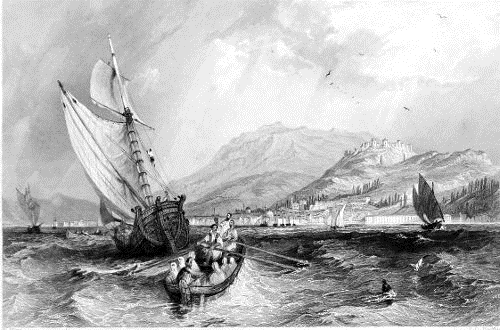
T. Allom. J. C. Bentley.
The Bay of Smyrna is one of the largest and deepest in the Levant. At the extremity rises the ancient city, crowning the distant hills, while the modern runs along the low ground below, and seems on a level with the sea. Ships from all nations crowd the water, and their various pennons, floating in the breeze, add to the gaiety of the scene. The French are particularly distinguished. On every fête-day there is kept up a kind of jubilee, and the gala of Paris seems transferred to this port: music resounds from every deck; boats filled with joyous company are continually moving from ship to ship on visits of ceremony; and the explosion of cannon, rebounding in echoes along the distant hills, announce their arrival and departure. In fact, of all the Frank nations, the French seem to consider this harbour as their own; and the Turks submit with a grave toleration to scenes of levity, of which they afterwards complain.
Several natural phenomena confer on this harbour peculiarities not elsewhere observed. Sometimes the power of refraction is so great as altogether to change the aspect and distance of objects. Ships sailing up, see the city as it were just under their bows, when suddenly it disappears; and when it is again perceptible, it is on the distant horizon. From the constant action of the sun on the air, at the extreme end of the harbour, where it is encircled by an amphitheatre of high hills, a considerable degree of rarefaction takes place, and the heated air ascending, leaves a vacuum below into which the colder rushes. This creates a continued current during the day, and causes that Inbat which we have before noticed. This constant and regular trade-wind is peculiarly favourable to the commerce of the port, as ships are wafted by it to their stations with the unerring certainty of steam-boats.
Some artificial works in this bay attest the wisdom and beneficence of one conqueror, and the energetic but barbarous sagacity of another, and still exist as memorials of their labours. The great promontory formerly the ancient Mount Mincas, shuts it up on the south, and considerably retards the navigation of the entrance; but at some distance the bay of Teos enters the land, and approaches so near to that of Smyrna, as to make their union no difficult enterprise. The great conqueror Alexander, therefore, pushed a communication across, so that ships entering the bay of Teos, pushed into that of Smyrna, and so avoided the dangerous navigation round the great promontory. There lies also the islands of Clazomenæ, not far from the shore; and as he had separated the land by a channel, he compensated by bridging the sea, and uniting the island to the main. The remains of both these works attract the curious traveller, and while they attest the activity and skill of the great captain, reproach the indolence and ignorance of the Turks, who, though it would be highly useful to repair them, and facilitate the approach to Smyrna, their great emperors consider such a thing as altogether beyond their comprehension and capability.
In the year 1402 Tamerlane besieged the city, and, in order to prevent all communication by sea, he ordered every soldier to take a stone in his hand, and drop it in the mouth of the harbour,−by this he hoped not only to keep out their allies, but to shut in all who would attempt to escape. The ships in the harbour passed over the mound before it was sufficiently high to obstruct their passage; and the disappointed barbarian caused a thousand prisoners to be decapitated, and with their heads, mixed with stones, erected a tower near the spot, to commemorate his attempt.
THE CASTLE OF ARGYRO-CASTRO, ALBANIA.
TURKEY IN EUROPE
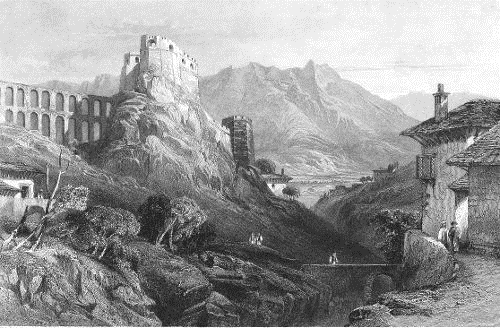
W. L. Leitch. J. Sands.
Among the wild and almost inaccessible mountains of Albania, the traveller is often astonished to enter suddenly on beautiful and fertile plains, where he expected nothing but a continuation of those rugged and sterile rocks, over which he had been painfully and perilously clambering. Of these the magnificent plain of Argyro-Castro is one of the most remarkable. It extends in length more than thirty miles, and varies from six to eight in breadth. It contains nearly one hundred villages, either hanging on the sides of its alpine barriers, or hidden in the recesses of the shadowy glens that cleave their sides. Through the centre winds the limpid stream of the Druno, imparting freshness and fertility to its verdant banks. Vast flocks of sheep whiten the plain below, and picturesque herds of goats hang on the crags above; and the whole scene, instinct as it were with life, gives to the wildness and majestic aspect of nature a singularly beautiful and interesting character.
At one extremity of this place, perched upon the summit of a precipice, stands the town of Argyro-Castro. The rock on which it is built is cleft into various fissures, so that the streets are divided by deep and yawning chasms, which separate it into various districts, and give it a character singularly different from any other town. The houses are of a size and structure superior to those in Albanian towns. They are not contiguous, or in the form of streets, leaning on one another for support. They stand single and independent, sometimes on the summit of a crag, sometimes on the side of a precipice, and sometimes concealed in the fissure of the rock. The greater number, however, are on level ground at the bottoms of ravines, and the street is the natural chasm of the mountain. The sides are lined with fruit-trees, flowing shrubs, and hanging gardens, so that every lane is a romantic mountain-glen. These picturesque streets, however, have their disadvantages. On the sudden solution of snows, or deluges of rain, the torrents from the higher ground rush with fearful impetuosity through them, devastating them from one end to the other, and leaving nothing behind, but torn-up trees, submerged houses, and drowned bodies.




